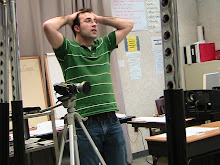Friday, October 23, 2009
Research and Feature Articles
However, research can get a little easier if you use some of the "useful sites" posted to the right side of this blog entry: IS 145 Media Center (scroll down for databases, and magazines), Internet Public Library and Teenspace, and PBS Newshour.
The best and most thorough search engine though, is EBSCO. Go to this site-
http://search.ebscohost.com/ and type in jp145 in both the username and password to begin searching.
Monday, October 19, 2009
Pitch
Please complete a final draft of your pitch letter. Your final draft should include your pitch cover sheet, and a sketch of your article's layout. (ALL PITCHES MUST BE HANDED IN THIS WEEK!)
833
You must have a sketch of your article's layout to be handed in on Wednesday.
Your final draft, cover sheet and layout sketch are due on Thursday this week.
Monday, October 12, 2009
Specialized High School Exam
Please see me tomorrow after lunch to get a permission slip. NO ONE will be permitted to this tutoring program unless they have a signed permission slip from their parent/guardian!
I look forward to working with you.
Friday, October 9, 2009
Homework Assigned for the Weekend (QUIZ WORDS & DEFINITIONS)
Quiz Words
Pitch: to sell or get approval for something
Demographic: A statistic about a group of people (ex- Women aged 30-60)
Bias: An unfair or unreasonable judgment of someone or something (usually a pattern of judgements found in the news)
Angle: the interesting approach to a general topic of study (the article isn't just about makeup, it's about how makeup should be applied for day or nighttime use)
Objective: A fair or balanced understanding, recognition of the truth without judgment
Caption: Written explanation of a graphic
Graphic: photos, graphs, illustrations used in a magazine
Sidebar: a section of an article separate from but related to the article.
Monday, October 5, 2009
Interviewing Possible Demographics (HW for 831 & 832)
SO, 831 and 832 your assignment is to interview one family member and one friend. Tell them your thoughts about your article and ask them what they would like to know about your topic. Why might they seek out an article like this? What type of information would they want to find in such an article? What do they find interesting about the topic and can they tell you anything about the topic that you might not have thought of yet?
Try to get your relative and friend to be as thorough as possible. You want them to talk to you so you can get good information from them.

The 7 Feature Types
THE HUMAN-INTEREST FEATURE
• This is the most common type of feature article. It describes an unusual aspect of the life of the very ordinary -- something that makes this individual interesting to others.
• This type typically reports on someone’s success in spite of great odds.
• It may recall a tragic predicament.
• It may share a continuing struggle supported only by hope and faith.
THE PERSONALITY FEATURE
• The subject of the article may be famous or not so famous but has done something of interest
to others.
• This type usually shows how a person gained recognition.
• The personality feature is very much like a character sketch.
“THE BEST” ARTICLES
• Many magazines have a column that publishes reviews of the “best” products of all kinds.
• This type of article usually includes the writer’s personal experiences with the product.
• It includes proof and examples that the product is the best of its kind.
• The article includes information about where to get the product and how much it costs.
PERSONAL EXPERIENCE (THE 1ST PERSON FEATURE)
• This type of article shares the author’s experience of something interesting or unusual
• It allows readers to do something through the eyes, ears, experiences and reflections of the author
THE HOW-TO / DIY FEATURE
• This article explains how to do something – usually a complex process that most people
would not know how to do.
• The best how-to articles begin by telling the reader why it is important or beneficial for him
or her to know how to do this.
• The article explains the steps of the process in enough detail so that another person can do
this process.
• This article also includes a list of all of the materials needed to do this process.
THE PAST EVENTS FEATURE
• This article focuses on an historical event or historical celebration.
• The article typically includes research but is not like an encyclopedia report. The article
serves as a human interest history lesson.
• This type of writing is usually puts a “human face” on history. In other words, it lets the
reader know something about the people who were part of history.
THE INFORMATIONAL FEATURE
• This type of article shows insightful coverage of a topic.
• It gives detailed information focused on one aspect of a given topic.
• The article often refers to sources of research but is not like an encyclopedia report. Instead,
Saturday, October 3, 2009
Homework assigned for the weekend (AND QUIZ NOTICE)
833: Finish your Alien Reports
834: Those of you who haven't handed in Alien Reports must have them handed in on Friday or I will start taking points off! Read 30 pages of your IR book and rewrite a conflict in the book from another character's perspective.
QUIZ COMING SOON: Vocabulary words for the unit at the end of the week!
Demographic
Caption
Angle
Bias
Perspective
Objective (as in this new story is objective)
Pitch
Graphic


